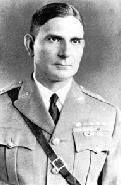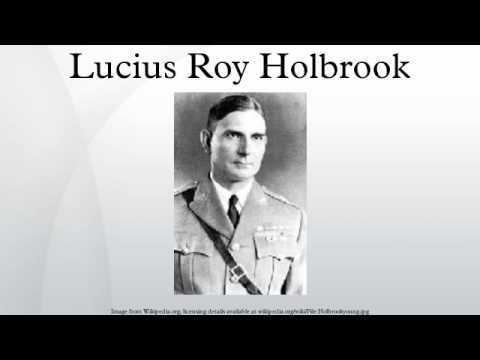Allegiance United States Name Lucius Holbrook | Years of service 1896–1939 | |
 | ||
Born April 30, 1875Arkansaw, Wisconsin ( 1875-04-30 ) Battles/wars Philippine–American War*Battle of Arayat*Battle of Cabiao*Battle of San Isidro*Battle of Santa Rosa II*Battle of TalaveraWorld War I Awards | ||
Lucius roy holbrook
Lucius Roy Holbrook (April 30, 1875 – October 19, 1952) was a Major General who commanded the United States Army's Philippine Department from 1936 to 1938.
Contents
- Lucius roy holbrook
- Early life and family history
- Military career
- Military decorations
- Dates of promotion
- Children
- Death
- References

Early life and family history
Holbrook was born in Arkansaw, Wisconsin. He was a son of Willard Francis and Mary (Ames) Holbrook. His father was born at Wrentham, Massachusetts, on April 27, 1827, and died September 17, 1886. Mary Ames, whom he married, was born November 19, 1840, at West Bridgewater, Massachusetts, and died July 12, 1889.
Holbrook graduated from high school in Northfield, Minnesota, in 1892. He entered the United States Military Academy on June 15, 1892 and graduated on June 12, 1896, as a second lieutenant in the Cavalry.
His brother, Willard, would also serve as a major general. His nephew, Willard, Jr., would also serve as a brigadier general.
Military career
Holbrook served with the 4th Cavalry Brigade at Fort Walla Walla, Washington, until December 22, 1896, and at Boise Barracks, Forts Sherman and Wardner, Idaho, until May 1899. During his time at Boise, he met Henrietta Coffin, (January 7, 1877 – March 28, 1965), the daughter of Frank R. Coffin, a merchant and baker and Charlotte Irene (Quivey) Coffin. The couple were married on June 7, 1899, at the Presidio of San Francisco in California and would go on to have three sons.
On June 24, 1889, Holbrook was posted to the Philippine Islands and during the Philippine–American War, he participated in the Northern Campaign, fighting in battles at Arayat, Cabiao, San Isidro, Santa Rosa, and Talavera. He then served with General Theodore Schwan's Southern Expedition from January 3 to February 18, 1900, and was at the Battles of Muntinlupa and Biñan, Carmona and Silan, Tiaong, Candaleria and Tayabas. Promoted to first lieutenant on January 23, 1900, later in the year he was posted to Troop H, 6th Cavalry Brigade, which was stationed at Boise Barracks in Idaho, until February 11, 1901.
Holbrook returned to the Philippines in March 1901 and served with Troop B, 15th Cavalry Brigade and Troop I, 4th Cavalry Brigade, based at Manila, until July 1, 1901 and at Fort Riley, Kansas until August 7, 1902.
He was promoted to Captain on July 15, 1902.
He was then assigned to Camp Stotsenburg, in the Philippines, until June 14, 1903. He returned to the US and served at Fort Logan, Colorado, and Fort Huachuca, Arizona, until August 28, 1904.
Holbrook was a distinguished graduate of the Infantry-Cavalry School at Fort Leavenworth, Kansas on July 2, 1905 and then attended the Staff College, Fort Leavenworth until July 25, 1906.
Holbrook was the umpire for maneuvers at Fort D.A. Russell, Wyoming (later Fort Francis E. Warren) until September 16, 1906. He then joined the 5th Cavalry Regiment at Fort Wingate, New Mexico until October 24, 1907.
Holbrook was assigned to the Commissary Department where he commanded the first training school for army bakers and cooks until March 9, 1911. During this time, he wrote the army's first cooking manuals. He was assisted in this endeavor by Color Sergeant, later Major Patrick Dunne. These works include:
Holbrook then served as Assistant to the Chief Commissary, Maneuver Division, San Antonio, Texas, until July 21, 1911 and at Fort Riley until September 20, 1911. He was then ordered to Paris, France, where he attended the Ecole de L'Intendance (the French Army School of Supply) until December 15, 1912.
Holbrook was stationed at Schofield Barracks, Hawaii until April 4, 1916 and was then a Quartermaster at Fort Riley, until July 1916. In 1916, he served with General John J. Pershing's Mexican Expeditionary Forces, as commander of the bakeries. This was the first use of the army field oven, which he had invented.
He was promoted to major on July 1, 1916.
Holbrook then served at Fort Sam Houston, Texas, until March 7, 1917 where he was in command of the 7th Field Artillery Brigade, of the 1st Division, and he sailed with it for France on July 31, 1917. When the United States became involved in World War I, this was the first artillery unit to be sent to France, and it fired the first US artillery shell against Germany.
While with the American Expeditionary Force, Holbrook was at Le Valdahon, from August 14 to October 18, 1917; at Sommerviller Sector, October 21 to November 20, 1917; Ansauville Sector, January 19 to April 4, 1918; Cantigny Sector, April 20 to June 8, 1918; Montdidier-Noyon Defense, June 9 to 13, 1918; and Saizerais Sector, August 4, to 16, 1918.
Holbrook was promoted to the temporary rank of general on August 16, 1918.
He then commanded the 54th Field Artillery Brigade, in training until October 3, 1918; served with the 1st Field Artillery Brigade, in the Meuse-Argonne Offensive, until November 7, 1918; and again commanded the 54th Field Artillery Brigade, at Chateau Reynel and elsewhere until May 22, 1919.
Holbrook returned to the United States in May 1919 and commanded Camp Bragg, North Carolina, from May 16, 1919 until July 1, 1919, when he became the head of the Artillery Department of the Command and General Staff School at Fort Leavenworth, Kansas.
On July 15, 1919, he reverted to the rank of lieutenant colonel. On February 24, 1920, he was promoted to colonel.
From January 27, 1921 to May 4, 1922, Holbrook served as Assistant Chief of Staff for Supply, Ninth Corps Area; and as Chief of Staff, Ninth Corps Area until June 30, 1924. After this assignment, he became the Chief of Staff, Non-Divisional Group, Organized Reserves, Ninth Corps Area, until June 30, 1925; and Inspector, Ninth Corps Area, until October 19, 1925.
He was promoted to Brigadier General on October 20, 1925.
Holbrook then commanded troops at Fort Douglas, Utah, until August 19, 1926. Holbrook then commanded Camp Stotsenburg, in the Philippines until May 11, 1929. Afterwards, he commanded Fort Bragg, North Carolina, from August 20, 1929 until October 5, 1930, when he became commander of the 1st Division and Fort Hamilton, New York, until November 9, 1935.
He was promoted to Major General on December 28, 1933.
On January 22, 1936, became commanding general of the Philippine Department until 1938.
Holbrook retired on January 31, 1939.
Military decorations
Dates of promotion
Children
The Holbrooks became the parents of the following children:
Death
Major General Lucius R. Holbrook died on October 19, 1952, at Letterman Army Hospital. His remains were taken by train to Boise, Idaho.
